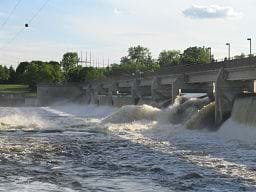Quick Look
Grade Level: 6 (6-8)
Time Required: 45 minutes
Expendable Cost/Group: US $0.00
Group Size: 3
Activity Dependency: None
Subject Areas: Life Science
Summary
Students build on their understanding and feel for flow rates, as gained from the associated Faucet Flow Rate activity, to estimate the flow rate of a local river. The objective is to be able to relate laboratory experiment results to the environment. They use the U.S. Geological Survey website (https://waterdata.usgs.gov/nwis/rt) to determine the actual flow rate data for their river, and compare their estimates to the actual flow rate. For this activity to be successful, choose a nearby river and take a field trip or show a video so students gain a visual feel for the flow of the nearby river.
Engineering Connection
Civil engineers design the systems that bring water from natural resources, such as rivers or lakes, to the communities where that water is needed. Civil engineers also oversee natural systems, such as river basins and watersheds, for flood control and drought mitigation. Completing this activity gives students a greater understanding for what civil engineers who design water systems do, as well as the skills they use.
Learning Objectives
After this activity, students should be able to:
- Use experimental data to formulate hypotheses.
- Use the Internet to find the flow rate of a specific river.
- Analyze discrepancies between estimated and actual data.
Educational Standards
Each TeachEngineering lesson or activity is correlated to one or more K-12 science,
technology, engineering or math (STEM) educational standards.
All 100,000+ K-12 STEM standards covered in TeachEngineering are collected, maintained and packaged by the Achievement Standards Network (ASN),
a project of D2L (www.achievementstandards.org).
In the ASN, standards are hierarchically structured: first by source; e.g., by state; within source by type; e.g., science or mathematics;
within type by subtype, then by grade, etc.
Each TeachEngineering lesson or activity is correlated to one or more K-12 science, technology, engineering or math (STEM) educational standards.
All 100,000+ K-12 STEM standards covered in TeachEngineering are collected, maintained and packaged by the Achievement Standards Network (ASN), a project of D2L (www.achievementstandards.org).
In the ASN, standards are hierarchically structured: first by source; e.g., by state; within source by type; e.g., science or mathematics; within type by subtype, then by grade, etc.
NGSS: Next Generation Science Standards - Science
-
Analyze and interpret data to determine similarities and differences in findings.
(Grades 6 - 8)
More Details
Do you agree with this alignment?
-
Conduct an investigation to produce data to serve as the basis for evidence that meet the goals of an investigation.
(Grades 6 - 8)
More Details
Do you agree with this alignment?
Common Core State Standards - Math
-
Fluently add, subtract, multiply, and divide multi-digit decimals using the standard algorithm for each operation.
(Grade
6)
More Details
Do you agree with this alignment?
International Technology and Engineering Educators Association - Technology
-
Interpret the accuracy of information collected.
(Grades
6 -
8)
More Details
Do you agree with this alignment?
-
Use devices to control technological systems.
(Grades
6 -
8)
More Details
Do you agree with this alignment?
State Standards
Colorado - Math
-
Fluently add, subtract, multiply, and divide multidigit decimals using standard algorithms for each operation.
(Grade
6)
More Details
Do you agree with this alignment?
Materials List
- River Flow Rate handouts, as found in the attached Flow Rate Experiment Student Guide
- computers with Internet access
Worksheets and Attachments
Visit [www.teachengineering.org/activities/view/csm_engineering_our_water_lesson1_activity2_tg] to print or download.Introduction/Motivation
Understanding flow rate and determining the flow rate of rivers is important in engineering analysis and design so that our infrastructure provides sufficient amounts of water when and where it is needed. Now that you have first-hand experience with flow rates from water faucets, let's extend your flow rate knowledge to rivers and streams.
Procedure
Before beginning the activity with students, use the data on the USGS website to locate the flow rates for rivers in your geographical area.
- Hand out the River Flow Rate handouts.
- Introduce and explain the activity to students.
- Have students assemble into their groups, and write down their hypotheses (best estimates) about the flow rate of a local river. For greatest benefit, choose a nearby river that students are familiar with, or take a field trip.
- Have each student group assemble at a computer with Internet access. If computers are limited, do this portion of the activity as a class. Bring up the Daily Streamflow Conditions page at the USGS Current Water Data for the Nation website at https://waterdata.usgs.gov/nwis/rt.
- If students have never used the USGS website, walk through the process to find the flow rate for an example river.
- Have student teams complete the worksheets.
- As a class, compare estimates and real-world flow rate data.
Assessment
At activity end, compare estimates and real-world data. Collect and review worksheet answers to gauge students' comprehension of the subject matter.
Subscribe
Get the inside scoop on all things TeachEngineering such as new site features, curriculum updates, video releases, and more by signing up for our newsletter!More Curriculum Like This

Students are given background information to prepare them to conduct two associated activities in which they conduct hands-on experiments with a common faucet and then work with real-world USGS streamflow data to gain a better understanding of flow rate and how it pertains to engineering and applied...

Students conduct experiments to determine the flow rate of faucets by timing how long it takes to fill gallon jugs.
Copyright
© 2013 by Regents of the University of Colorado; original © 2005 Colorado School of MinesContributors
Bobby Rinehart; Karen Johnson; Mike MooneySupporting Program
Civil and Environmental Engineering Department, Colorado School of MinesAcknowledgements
This curriculum was created with support from the National Science Foundation. However, these contents do not necessarily represent the policies of the National Science Foundation, and you should not assume endorsement by the federal government.
Last modified: August 24, 2021







User Comments & Tips